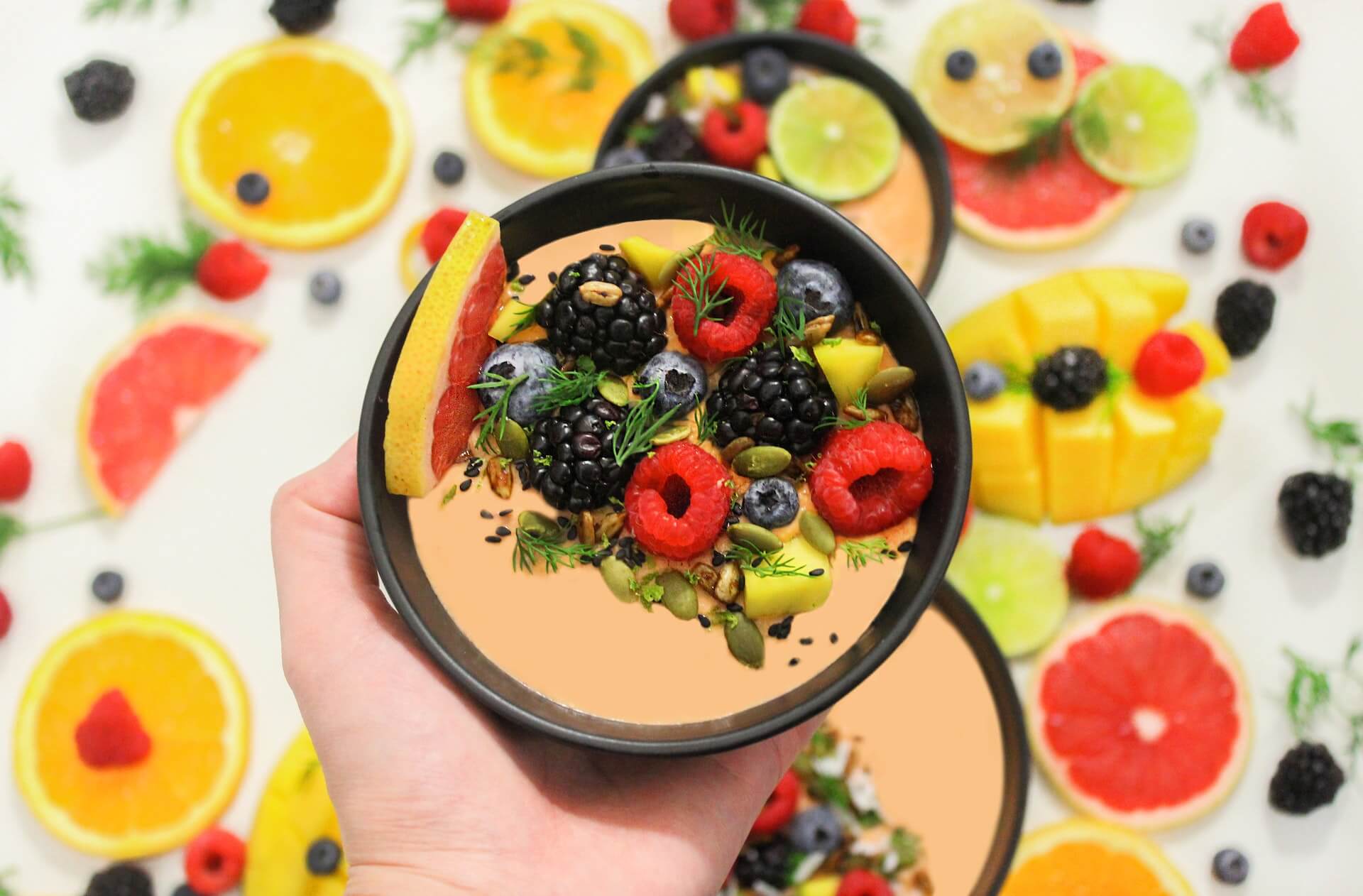Many believe adopting a keto diet entails eating meat, cheese, and butter. This, however, could not be further from the truth.
You may generate a lot of diversity in your diet if you keep your overall carbohydrates low.
Making a low-carb smoothie is one of the easiest ways to receive a nutritional boost without doing too much work. Most smoothies take less than five minutes to prepare and may keep you pleased for hours.
On the other hand, choosing the correct components is critical if you want your smoothie to keep you in ketosis while also providing you with various nutrients.
Avoid high-sugar fruits in most smoothies, such as bananas, mangoes, and pineapple. You should also avoid protein supplements that include high-carb components.
The options for keto smoothies are limitless if you’re aware of those two possible keto killers.

The Ultimate Keto Green Smoothie Formula
Whatever you put in your blender, the ultimate keto smoothie recipe must taste good, have the proper consistency, and have an optimal nutrient profile.
How did you accomplish this feat? By selecting one or two alternatives from the following groups:
- Protein
- Berries
- Dark leafy greens
- Milk
- Fat boost
- Extras

There are so many methods to mix and match that you’ll never grow tired of your keto smoothie.
Have fun with it! Here are some of the healthiest alternatives for each category:
Pick Your Protein (1 scoop or serving)
The macronutrient composition distinguishes a keto smoothie from a typical smoothie.
Most smoothie recipes are high in carbohydrates, but a keto smoothie will increase fat and protein with a low carb count.
You also want your smoothie to feel like a full meal, so obtain enough protein to satisfy you for hours.
Protein performs several functions in your body. Protein is required to form, process, and control all organs and tissues in your body. And amino acids from protein act as messengers and enzymes in your body’s systems [1].
Protein is also necessary for activating satiety hormones, which tell you when you’re full and don’t need more food [2]. Protein is essential if you want your smoothie to keep you full and content for hours.
Your objectives determine the sort of protein you pick. Here are some of our favorites, along with their advantages.
Whey Protein Powder
Whey is a fantastic choice to grow muscle and reduce weight.
Protein is composed of smaller components known as amino acids. Whey is high in all essential amino acids, particularly branched-chain amino acids necessary for muscle development and maintenance [3].
Whey protein has also been associated with lower body fat levels, particularly around the belly, making it an excellent choice for weight loss [4].
Whey protein is frequently available in a range of tastes and quality levels. Go for grass-fed protein isolate for the highest-quality, absorbable whey protein powder.
Collagen Powder
If you want to improve your joint or skin health, collagen protein is an excellent choice. Collagen is the principal structural protein in connective tissue, contributing to skin suppleness.
Including collagen protein in your shake may improve your skin’s elasticity, reducing the appearance of wrinkles. It may also help alleviate joint discomfort and can be used to treat osteoarthritis [5][6].
Collagen, on the other hand, lacks the full complement of amino acids found in whey protein. So, make sure to consume both whey and collagen daily.
Vegan Protein Powder
If you eat a plant-based diet, the protein group is very crucial. When you don’t eat animal products, it might be difficult to locate high-quality protein sources, but it’s not impossible.
Receiving a protein boost from a smoothie is one of the simplest methods for vegans and plant-based people to ensure their protein needs are fulfilled.
The key here is to achieve a complete amino acid profile without adding too many extra carbohydrates. Plant-based proteins include pea protein, hemp protein, and pumpkin seed protein.
It’s also worth noting that while vegetables are essential on a keto diet, an utterly plant-based keto diet isn’t sustainable.
Throw In Some Berries (About ½ Cup)
A smoothie is only complete with a blast of fruit. Even a keto smoothie qualifies.
Replace high-sugar fruits like bananas, mangoes, and other tropical fruits with a small handful of berries. Berries like strawberries, blackberries, and raspberries are high in antioxidants and other nutrients but low in new carbohydrates.
The berries in your smoothie fulfill several functions:
- Add a sweet flavor
- Bulk it up a bit for a richer consistency
- Enhance the nutrient quality with antioxidants, vitamins, and minerals
Berries are one of the plant world’s finest sources of antioxidants. They’re low in calories, fiber, and phytonutrients such as anthocyanins, ellagitannins, and zeaxanthin. All of these things can help to reduce inflammation and oxidative stress [7][8][9].
When berries aren’t in season, frozen berries lend an ice touch and make more sense. Fresh berries are delicious in the spring and summer when picked from the vine.
If all you have are fresh berries and a desire for a cold smoothie, add some ice cubes and enjoy.
Here are some of the best low-carb berries:
- Blueberries
- Raspberries
- Acai berries
- Strawberries
Get Your Dark Leafy Greens (About 2 Cups)
Including dark leafy greens in your smoothie is an excellent way to incorporate these superfoods into your diet. They are usually the least exciting item on the menu and sometimes provide the perfect flavor, but their nutritional profile is worth it.
Green leafy veggies are high in fiber, antioxidants, vitamins, and minerals. Some excellent choices for your daily greens include:
Kale
This should not come as a surprise. With its dark green leaves packed with fiber and minerals, kale has become the poster child for healthy veggies. Kale is exceptionally high in vitamin K, with one cup providing 81 mcg, nearly meeting your daily requirements.
Spinach
Spinach is a common ingredient in smoothies. It includes nitrates, which may assist your heart health, and is high in folate, vitamin A, and vitamin K [10].
Spinach is a great leafy green alternative if you don’t like the fibrous kale and collards.
Collards
Collard greens have a high calcium content of 268 mg per cup. That amounts to about 25% of your daily calcium requirements. You can easily sneak a cup of chopped collards into your smoothie without realizing it.
Microgreens
Microgreens are mature green leafy vegetable seedlings plucked immediately after forming the first leaves. Microgreen assortments comprising spinach, kale, arugula, and other greens are commonly seen in grocery shops.
You may also make your microgreens at home.
Their leaves may be small, but they are densely packed with nutrients. Your microgreens blend contains varying amounts of vitamins, minerals, antioxidants, and phytonutrients [11].
Dandelion Greens
Dandelion greens are the food to eat to assist in liver cleansing.
Dandelion, besides vitamins and minerals, is an excellent source of antioxidants. While you should consume a variety of antioxidants, the antioxidants in dandelion are particularly beneficial to your liver.
In one study, dandelion extracts had a hepatoprotective (liver-protective) impact on mice with liver damage [12].
Swiss Chard
Blend up some Swiss chard to give your smoothie a fiber boost. Almost half of the carbs in Swiss chard come from fiber, making it an excellent fiber-boosting ingredient.
Add Milk (Or Dairy-free Milk) (½ Cup)
If you don’t have any milk, you can always add water to your smoothie, but milk is the way for a creamier shake.
If you consume dairy, pick full-fat, organic milk – grass-fed is even better.
If you’re not a dairy fan, there are many alternatives. Hemp milk, cashew milk, almond milk, macadamia milk, coconut milk, and flax milk are also beautiful options.
One thing to remember when selecting non-dairy milk: examine the ingredients to ensure that it doesn’t include added sugar or is too high in carbohydrates.
Add a Fat Boost (1 Serving or 1 Tablespoon)
A keto smoothie would only be complete with a bit of additional fat.
Maintaining a macronutrient profile higher in fat and protein and lower in carbohydrates allows you to incorporate some fantastic high-fat items.
Here are a few high-fat choices to consider:
MCT Oil or Powder
MCTs (medium chain triglycerides) are an excellent method to boost the energy in your smoothie. Unlike long-chain fatty acids, which must travel via your lymph, MCTs are sent straight to your liver for utilization as fuel.
This makes MCTs an excellent addition to a smoothie before a workout [13].
MCTs are available in both liquid and powder form. However, both make excellent smoothie ingredients. If you’re not used to MCTs, start with ¼ or ½ a serving and gradually increase over two weeks.
Nut Butter
Add some nut butter to your smoothie if you want it to taste extra rich. Use almond, cashew, hazelnut, or a keto nut butter blend to increase your smoothie’s fat and protein content.
Coconut Oil
Coconut oil is packed with health advantages. To keep the flavor neutral, coconut oil is a good alternative for increasing the fat level.
It contains not just MCTs but also a fatty acid called lauric acid, which is not present in MCT mixes.
If you’re feeling under the weather, add a spoonful of coconut oil to your smoothie [14].
Avocado
If you want your smoothies to be exceptionally creamy, avocado will add a nice texture. Because avocados can thicken things significantly, you only need ¼- ½ of a medium or large avocado.
Avocados include monounsaturated fats, which can help regulate cholesterol and reduce heart disease risk [15].
Keto-Friendly Extras
Now that you’ve covered the fundamentals, here are some additions to consider for a unique touch on flavor, texture, and nutrition.
Monk Fruit
You might need more than the berries if you want your smoothies to be delightful. Monk fruit is a great sugar-free option that won’t raise blood sugar.
Lemon Peel
That’s correct; the entire peel. Many of the nutrients in lemon are found in its peel. Smoothies are a great way to receive the nutrients from the peel without eating it.
Limonene, a phytochemical present in lemon peel, has been shown to aid with blood pressure regulation, inflammation, liver health, and obesity, to name a few benefits [16][17][18][19].
To avoid spray residues, use organic or home-grown lemons.
Turmeric
Turmeric is everywhere these days. This ancient herb has been utilized as a medicinal plant in Indian culture for thousands of years. And the advantages are scientifically supported.
Turmeric’s anti-inflammatory qualities are one of its most well-known advantages. Turmeric may be as beneficial as medications in the treatment of inflammation.
A teaspoon of turmeric in your smoothie is an excellent way to get this superfood into your diet [20].
Medicinal Mushrooms
Medicinal mushrooms are quickly catching up to turmeric regarding health-boosting dietary trends. These have been around for thousands of years, but mainstream nutrition has only scratched the surface of what they can do for your health.
Many medicinal mushrooms, such as Chaga, reishi, cordyceps, and lion’s mane, are available in powdered form, making them ideal for adding to your smoothie.
Chia Seeds
If you want to add some nutritional fiber to your smoothie without the ultra-creaminess of avocado, chia seeds are a terrific option. However, if you leave them too long, they will absorb the liquid in your smoothie, and you may end up with a solid blob.
Fresh Herbs
If you like the flavor of mint, you may add some mint leaves to your smoothie to get that fresh taste you’re searching for. Combine your mint leaves with some chocolate whey protein to make something resembling a thin mint girl scout cookie.
A few sprigs of basil, rosemary, or lemon balm can also be added to any smoothie to enhance the flavor and polyphenol content.
The Formula Recap
Here’s a brief rundown of your low-carb green smoothie recipe; select one or two alternatives from each area and enjoy!
Protein
- Whey Protein
- Collagen
- Vegan protein
Berries
- Blueberries
- Raspberries
- Acai berries
- Strawberries
Green Leafy Vegetables
- Kale
- Spinach
- Collards
- Microgreens
- Dandelion greens
- Swiss chard
Milk
- Full-fat, grass-fed organic milk
- Almond milk
- Cashew milk
- Macadamia nut milk
- Coconut milk
- Hemp milk
- Flax milk
Fat Boosts
- MCTs
- Nut Butter
- Coconut oil
- Avocado
Extras
- Monk fruit
- Lemon peel
- Turmeric
- Medicinal mushrooms
- Chia seeds
- Mint leaves
Example Green Keto Smoothie
One scoop of Keto Vanilla Whey Protein
½ cup blueberries
Two cups chopped kale
½ cup unsweetened hemp milk
One scoop of Keto MCT Oil Powder
One teaspoon turmeric
The Bottom Line
If you thought following a keto diet meant missing out on all the smoothie fun, think again. This article has you covered.
Smoothies are a great way to replace breakfast or lunch while getting various nutrients into your diet.
Your primary objective as a keto dieter is to keep your total carbohydrates low and your smoothie balanced with protein and fat.
There are many keto-friendly ingredients to experiment with, so have fun with your smoothie ideas, mix, match, and try new things.
What is your favorite green smoothie recipe? We’d love to hear your thoughts in the comments. Do you need some more inspiration? You may find hundreds of keto recipes every week, including new keto smoothie ideas, Here.






![How Low Carb and Ketogenic Diets Boost Brain Health [Benefits & Effects]](https://eathealthyisgood.com/wp-content/uploads/2023/11/pexels-ella-olsson-1640773-1-1080x675.jpg)
What an amazing post! Your writing is so engaging and your points are very well presented. Keep up the fantastic work!
Thank you for your word and support its my pleasure